 Saint Apollinaris
Saint Apollinaris
The small red line to the left of Apollinaris shows indicates an area of the mosaic that is restored. I wish more mosaics were restore like this rather than leaving hideous open areas. Daphni is an example or good restoration that was done in the 1890s. Even that should have gone further. I see no reason not to restore plain gold backgrounds and decorative borders so long as you see the areas that have been repaired like this. Saint Apollinaris was a Bishop of Ravenna during the reign of the Roman Emperor Vespasian, who was martyred. This mosaic is in the apse of his church in the port city of Ravenna, Classe, which was a headquarters of the Roman fleet that was expanded by Augustus.
Virgin Martyr of Ravenna
On the left side of the church is a procession of 22 Virgins in mosaic of the Byzantine period, led by the Three Magi, moving from the city of Classe towards the group of the Madonna and Child surrounded by four angels.

Justinian I, Roman Emperor
He was emperor from 527 until 565. During his reign large part of the Western Empire, including Italy and Ravenna was recovered for the empire. His representatives there had the Church of San Vitale decorated with mosaics. This portrait of Justinian was taken from life and sent to Ravenna where it was inserted into the plaster as a part of a large procession of him along with military officers and high-church officials that were added by local mosaic artists.
Theodora, Empress and Augusta
She was born in the year 500 and died in 548. Theodora was a famous former actress and courtesan. She is most famous for saying "royal purple is the noblest shroud" when asked her opinion on whether she and her husband should flee by boat during riots in Constantinople. As a result of her defiance, Justinian ordered his loyal troops, led by his general Belisarius, to attack the rioters in the hippodrome, killing over 30,000 of them. After Theodora died of cancer she and her husband were made saints in the orthodox church. This mosaic is one of only two or three portraits of her to survive.

Sheep from Saint Apollinaris in Classe
Here are two sheep from the geat pse mosaic of the church of Saint Apollinaris in Classe. The sheep are symbols of humanity who are gathered together and protected by the Good Shepherd - Christ. There was a great marble frieze of sheep processing into Hagia Sophia above the colonnade of the Theodosian ancestor-churchof Justinian's great cathedral. It's remains are laid in front of the other narthex of the church.
 Saint from Saint Apollinaris Nuovo
Saint from Saint Apollinaris Nuovo
The next row of mosaics are a scheme of haloed saints, prophets and evangelists, sixteen on each side. The figures are executed in a Hellenistic-Roman tradition and show a certain individuality of expression as compared to the other figures in the basilica. Each individual depicted holds a book, in either scroll or codex format, and, like many of the other figures throughout the basilica, each of their robes has a mark or symbol in it. They all wear white tunics and himations. These mosaics alternate with windows. The robes are made of three shades of white marble and limestone cubes. The gold background is studded with red terracotta cubes. This was intentional and toned down and made the background look less garish. Silver cubes were lso added to the backgrounds of Hagia Sophia. This mosaic was made in the time of Theodoric. 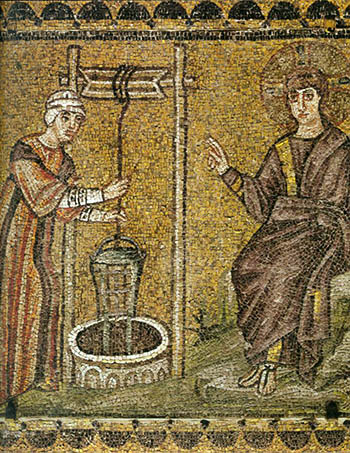
Christ and the Samaritan Woman
Justinian had the original well brought to Constantinople from Palestine where it was installed in the Chapel of the Holy Well on the right side of the sanctuary of Hagia Sophia. The circular well head existed in its original location until the 6th century, when it was moved tho the church because riots and church burnings in Samaria threatened it with destruction.
Justinian had attempted to suppress the Samaritan religion through forced conversions which evoked violent reaction from the people. The Holy Well was in Hagia Sophia at least until 1453.

Palace of Theodoric
Above is a portion of the the palace of Theodoric from the Church of Saint Apollinaris Nuovo. He was an Arian Christian, which was an early heresy in the church that believed Christ was a human who became divine. The heresy was widspread, especially among the Germanic troops of the late Roman Empire. Constantine the Great - the first Christian Roman Emperor was said to have been an Arian.
After Theodoric's death and Justinian restored Italy to the Empire all images that depicted him and other people were removed from the mosaic and covered with other images. Of the original figures, the hands still remain on the columns of the palace. You can see the remnants of a ghostly hand on the right hand column.


Ambo of the Church
It is made of Proconnesian marble from an island of in the Sea of Marmora near Constantinople. The ambo, columns and capitals of the church were all imported from here by ship. Originally the ambo was set in the center of the church.

Porphyry Ciborium Columns
There are four porphyry columns in the apse that come from the original Ciborium - altar - of the church. The roof would have been made of marble or even of silver. Justinian probably gave this church complete silver fittings for its sanctuary. You can see the columns are not the same size. One has a taller base to accommodate it. Porphyry was very rare, it came from the eastern desert of Egypt. The stone is hard and difficult to work. It is prone to split when too much weight is put on it. It was widely used in Roman times and was mined up until the time of Constantine. Later if you wanted porphyry columns ina church or palace you had to reuse them. They could be of odd sizes. All of the porphyry columns of Hagia Sophia are different lengths.
These columns have very pretty capitals, two are matching sets in white marble. You can learn more about porphyry in Hagia Sophia here.

Angel from San Vitale
In the vault of the apse of San Vitale are four angels in acanthus scrolls populated with doves, parrots and other birds holding an image of the Lamb of God, which is a symbol of the sacrifice of Christ for humanity. They are Hellenistic in style.
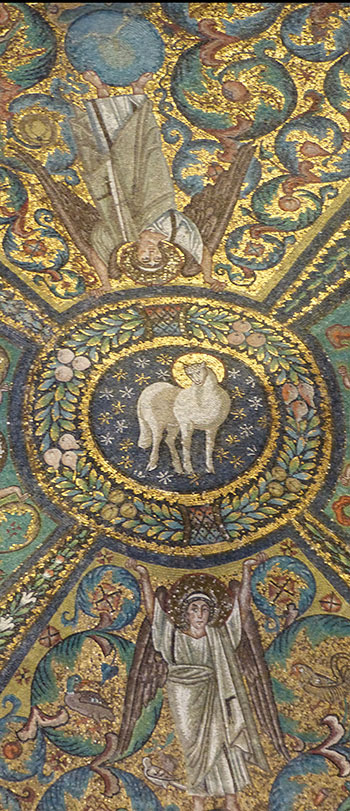
The Lamb of God
Here is a view of it. The green parrot has a cord around it's neck, showing it was a pet bird. You can learn more about Byzantine parrots here.

Christ Treads Upon the Devil
Above we can see a mosaic from the archbishop's Chapel showing Christ overcoming evil. He is dressed in the uniform of a military emperor and commander. The inscription reads from John 14.6: "I am the way, and the truth, and the life". From Psalm 91 we read - "Thou shalt tread upon the lion and adder: the young lion and the dragon shalt thou trample under feet".

Saint Lawrence
From the Mausoleum of Galla Placidia, which was built between 425-450. The mausoleum is reputed to have inspired American songwriter Cole Porter to compose "Night and Day" while on a 1920s visit.
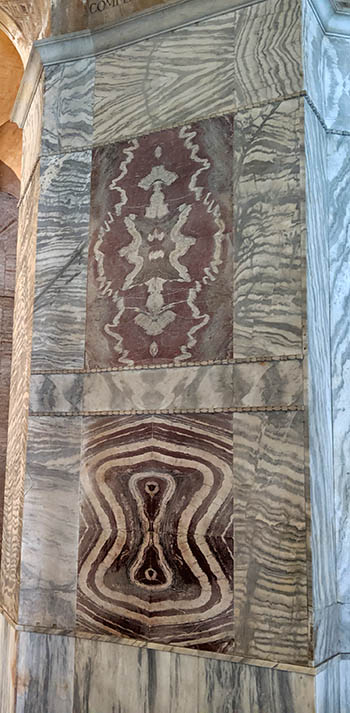
Marble Revetment from San Vitale
Here are two book-matched double panels of cippolino rosso marble set in bands of heavy veined in gray proconnesian white marble. Cipollino rosso, also called Carian or Iasos marble, comes from Kiyi Kislacik in Mugla province, Turkey and is mined today.
If you would like to learn more about marble revetment in Byzantine churches - read this page.

 Isn't this interesting? Here we've got a Christ with purple hair. The artist who made his mosaic took the imperial purple color of the robe and used for His curls. This purple is the true imperial purple that was made from murex shells. Of course, this mosaic is made of glass cubes. In later times the Byzantines created a substitute for murex dye that was a dark red. No one except the Emperor was allowed to wear it. Our course there was no limitation on purple being used in paintings and mosaics like this. From a distance the purple hair reads brown.
Isn't this interesting? Here we've got a Christ with purple hair. The artist who made his mosaic took the imperial purple color of the robe and used for His curls. This purple is the true imperial purple that was made from murex shells. Of course, this mosaic is made of glass cubes. In later times the Byzantines created a substitute for murex dye that was a dark red. No one except the Emperor was allowed to wear it. Our course there was no limitation on purple being used in paintings and mosaics like this. From a distance the purple hair reads brown. See the reflection of the red glass on the finger of Christ? He is sitting on a lyre-back throne that is hung with a green silk drape. The finials on the corners are golden pine cones. For the next 900 years Byzantine artists would depict him on a similar throne. The wide-set green cubes of the curtain are set in green painted plaster. The red glass bottle would have held scented oils or rose water. The thin top made it easier to dispense the oil by hand when it was used to anoint someone. If it isn't a bottle then it is a glass scepter.
See the reflection of the red glass on the finger of Christ? He is sitting on a lyre-back throne that is hung with a green silk drape. The finials on the corners are golden pine cones. For the next 900 years Byzantine artists would depict him on a similar throne. The wide-set green cubes of the curtain are set in green painted plaster. The red glass bottle would have held scented oils or rose water. The thin top made it easier to dispense the oil by hand when it was used to anoint someone. If it isn't a bottle then it is a glass scepter. The throne is set with big red silk pillow. Christ is dressed in a tunic and himation. The tunic has wide bands of gold. This is the "official" outfit of Christ henceforth. The artist has used naturalistic shading in the gold of the clothing and the footstool. This technique dies out soon after this. Notice how the perspective of the footstool is accurate as well
The throne is set with big red silk pillow. Christ is dressed in a tunic and himation. The tunic has wide bands of gold. This is the "official" outfit of Christ henceforth. The artist has used naturalistic shading in the gold of the clothing and the footstool. This technique dies out soon after this. Notice how the perspective of the footstool is accurate as well Christ is attended by angels. Notice how small the heads are. This was a mistake and not intentional. I think someone did the drawings before the mosaic was done. The outlines of the face were done without the features of the faces. When the mosaic artists laid the cubes it was apparent they had been designed too small. It was too late to fix it.
Christ is attended by angels. Notice how small the heads are. This was a mistake and not intentional. I think someone did the drawings before the mosaic was done. The outlines of the face were done without the features of the faces. When the mosaic artists laid the cubes it was apparent they had been designed too small. It was too late to fix it. The female martyrs carry heavenly crowns of martyrdom. Each saint has her own inscription identifying each one of them. The artists have varied the hair color and styles. They also changed the clothes and jewels. Some hands are covered while others are bare.
The female martyrs carry heavenly crowns of martyrdom. Each saint has her own inscription identifying each one of them. The artists have varied the hair color and styles. They also changed the clothes and jewels. Some hands are covered while others are bare.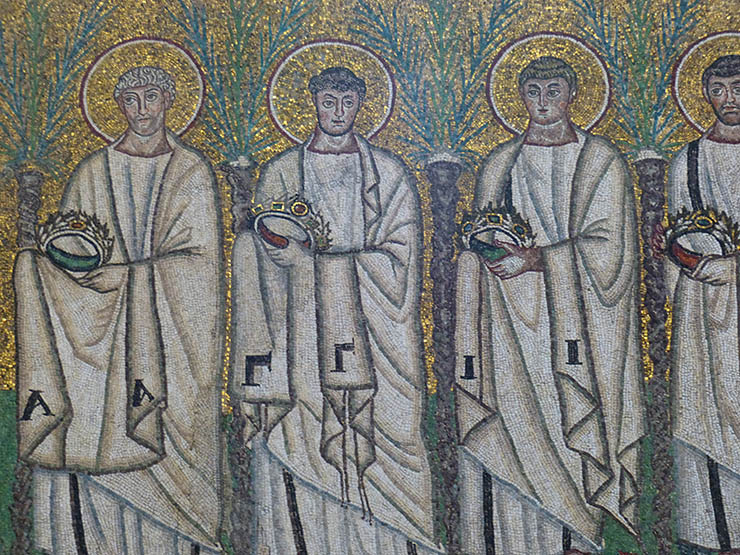 The men are all dressed in white tunics and himations. The clothing is all made of just a few colors of mosaic made of marble and stone cubes. The men are of all ages. Their hands are covered and uncovered.
The men are all dressed in white tunics and himations. The clothing is all made of just a few colors of mosaic made of marble and stone cubes. The men are of all ages. Their hands are covered and uncovered.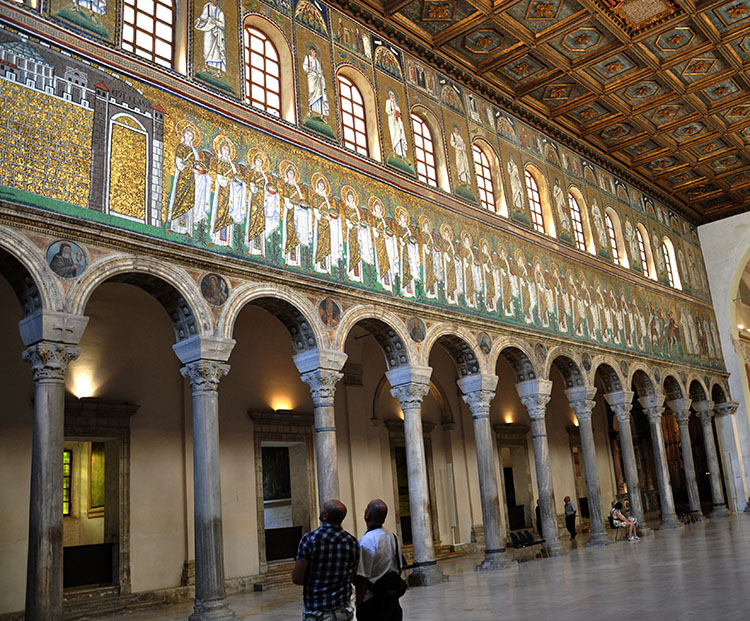

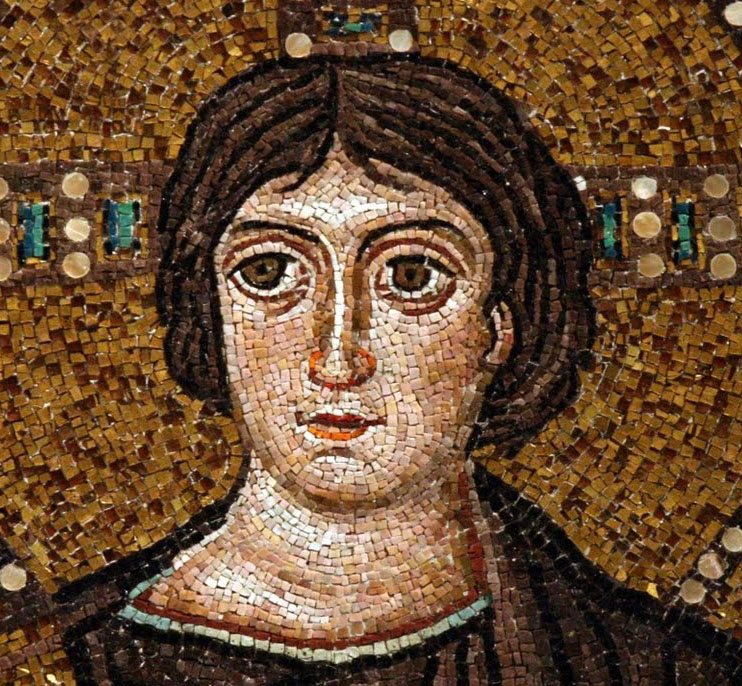 Here we see Christ in Glory at the Second Coming. From the latter part of the fourth century, a still beardless Christ begins to be depicted seated on a throne on a dais, often with his feet on a low stool and usually flanked by Saints Peter and Paul, and in a larger composition the other apostles. Here Christ is shown on a celestial throne represented as a ball of blue light. He is flanked by two angels a saint Vitalis, to whom the church was dedicated and a cleric presenting a model of the church.
Here we see Christ in Glory at the Second Coming. From the latter part of the fourth century, a still beardless Christ begins to be depicted seated on a throne on a dais, often with his feet on a low stool and usually flanked by Saints Peter and Paul, and in a larger composition the other apostles. Here Christ is shown on a celestial throne represented as a ball of blue light. He is flanked by two angels a saint Vitalis, to whom the church was dedicated and a cleric presenting a model of the church.
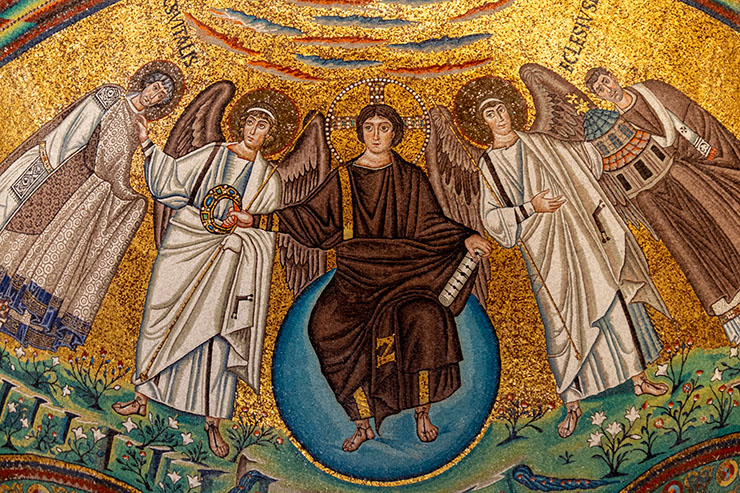 Notice how the angels have placed their hands on the shoulders of Vitalis and the cleric holding the model of the church. In the ceremony of the Imperial court two guards held your shoulders like this when you were lead into the presence of the emperor.
Notice how the angels have placed their hands on the shoulders of Vitalis and the cleric holding the model of the church. In the ceremony of the Imperial court two guards held your shoulders like this when you were lead into the presence of the emperor. The church was begun by Bishop Ecclesius in 526, when Ravenna was under the rule of the Ostrogoths and completed by the 27th Bishop of Ravenna, Maximian, in 547 preceding the Byzantine Exarchate of Ravenna. It was built as an octagonal, domed church. Originally the church was completely clad in colorful marble revetment, but much of it was removed by the Emperor Charlemagne around 795 to adorn his Palatine Chapel in Aachen, Germany.
The church was begun by Bishop Ecclesius in 526, when Ravenna was under the rule of the Ostrogoths and completed by the 27th Bishop of Ravenna, Maximian, in 547 preceding the Byzantine Exarchate of Ravenna. It was built as an octagonal, domed church. Originally the church was completely clad in colorful marble revetment, but much of it was removed by the Emperor Charlemagne around 795 to adorn his Palatine Chapel in Aachen, Germany.
 This image of Christ dates from the last years of the fifth century - almost 300 years earlier than the Pantokrator in the last picture - and is located in the Archbishop's Chapel on the first floor of the bishops' palace in Ravenna. The chapel was built by Peter II after he became archbishop in 495, a year after Theodoric's conquest of Ravenna. Peter, an Orthodox bishop, had a close relationship with Theodoric, the Ostrogothic king of Italy, despite his being an Arian heretic. The mosaics date from the original construction. This is the only surviving private chapel from Late Antiquity. It is small and isolated from the rest of Ravenna. It was possibly used as a baptistery as well as a chapel.
This image of Christ dates from the last years of the fifth century - almost 300 years earlier than the Pantokrator in the last picture - and is located in the Archbishop's Chapel on the first floor of the bishops' palace in Ravenna. The chapel was built by Peter II after he became archbishop in 495, a year after Theodoric's conquest of Ravenna. Peter, an Orthodox bishop, had a close relationship with Theodoric, the Ostrogothic king of Italy, despite his being an Arian heretic. The mosaics date from the original construction. This is the only surviving private chapel from Late Antiquity. It is small and isolated from the rest of Ravenna. It was possibly used as a baptistery as well as a chapel. Above is Christ between the Apostles Paul and Peter in the eastern arch.
Above is Christ between the Apostles Paul and Peter in the eastern arch. There are two arches with mosaics of Christ in the chapel. Above is the western arch. Christ is shown here between the Apostles James and Thomas. On the far right is Matthew.
There are two arches with mosaics of Christ in the chapel. Above is the western arch. Christ is shown here between the Apostles James and Thomas. On the far right is Matthew. The chapel's vaults - a Theophany - were meant to represent the light-filled heavens. This lavish interior was praised for generating its own light.
The chapel's vaults - a Theophany - were meant to represent the light-filled heavens. This lavish interior was praised for generating its own light.



 click here for icons of christ
click here for icons of christ click here for icons of the theotokos
click here for icons of the theotokos click here for icons of angels
click here for icons of angels click here for icons of saints
click here for icons of saints








